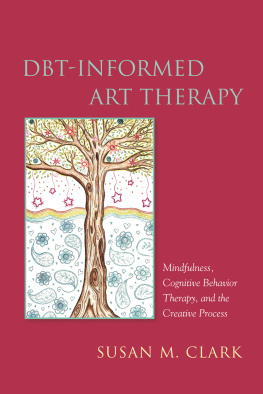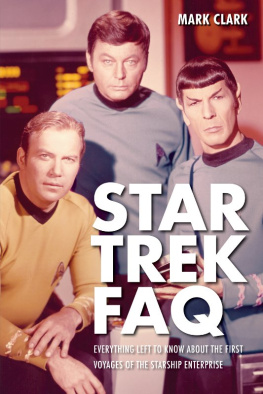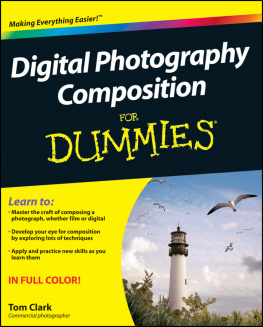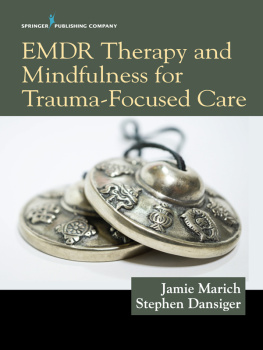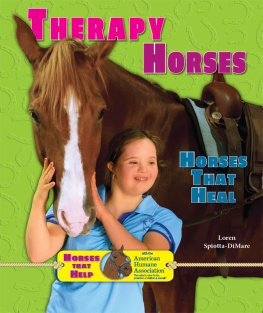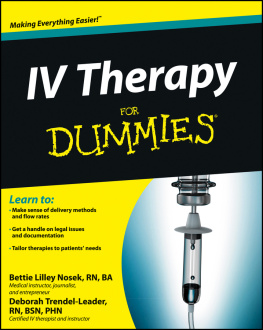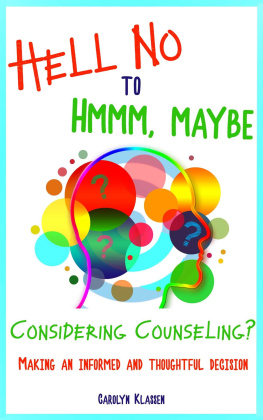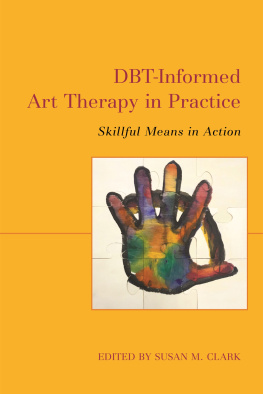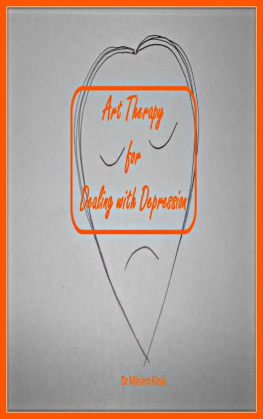Clark - DBT-Informed Art Therapy
Here you can read online Clark - DBT-Informed Art Therapy full text of the book (entire story) in english for free. Download pdf and epub, get meaning, cover and reviews about this ebook. year: 2016, publisher: Jessica Kingsley Publishers, genre: Romance novel. Description of the work, (preface) as well as reviews are available. Best literature library LitArk.com created for fans of good reading and offers a wide selection of genres:
Romance novel
Science fiction
Adventure
Detective
Science
History
Home and family
Prose
Art
Politics
Computer
Non-fiction
Religion
Business
Children
Humor
Choose a favorite category and find really read worthwhile books. Enjoy immersion in the world of imagination, feel the emotions of the characters or learn something new for yourself, make an fascinating discovery.
- Book:DBT-Informed Art Therapy
- Author:
- Publisher:Jessica Kingsley Publishers
- Genre:
- Year:2016
- Rating:5 / 5
- Favourites:Add to favourites
- Your mark:
- 100
- 1
- 2
- 3
- 4
- 5
DBT-Informed Art Therapy: summary, description and annotation
We offer to read an annotation, description, summary or preface (depends on what the author of the book "DBT-Informed Art Therapy" wrote himself). If you haven't found the necessary information about the book — write in the comments, we will try to find it.
Clark: author's other books
Who wrote DBT-Informed Art Therapy? Find out the surname, the name of the author of the book and a list of all author's works by series.
DBT-Informed Art Therapy — read online for free the complete book (whole text) full work
Below is the text of the book, divided by pages. System saving the place of the last page read, allows you to conveniently read the book "DBT-Informed Art Therapy" online for free, without having to search again every time where you left off. Put a bookmark, and you can go to the page where you finished reading at any time.
Font size:
Interval:
Bookmark:

DBT-INFORMED
ART THERAPY
Mindfulness, Cognitive Behavior
Therapy, and the Creative Process
SUSAN M. CLARK

Jessica Kingsley Publishers
London and Philadelphia
CONTENTS
INTRODUCTION
I am thrilled and humbled to offer the first book dedicated to DBT-informed art therapy, a subject that has captured my imagination and career path for many years. I am also grateful for this opportunity to share some of the ideas of like-minded creative arts therapists, from both the United States and abroad, who have been so generous with their time and expertise. The volume before you is the result of several unique perspectives and clinical backgrounds coming together to describe an original, exciting therapeutic approach. My hope is that it will play a role in fostering the development of DBT-informed creative arts interventions and programs.
Dialectical behavior therapy (DBT) is a popular, empirically supported treatment for borderline personality disorder (BPD) and other disorders of emotion regulation. An adapted form of cognitive behavior therapy (CBT), DBT combines respected psychological change strategies with training in mindful awareness, along with a strong emphasis on acceptance of oneself, ones problems, and the broader realities of the present moment. DBT was developed by Marsha Linehan, PhD, at the University of Washington during the late 1970s and 1980s. Its original intended client population were chronically impaired and highly suicidal women who often met the diagnostic criteria for BPD (Linehan 1993a), a group once considered untreatable due to the severity of their behavioral symptoms and dismal clinical outcomes. These individuals typically contend with serious comorbid mental illnesses, such as mood disorders and posttraumatic stress disorder (PTSD), and experience frequent debilitating life crises that precipitate and/or result from their profound affective vulnerability.
Over the years DBT has become extremely well known in the psychiatric and mental health communities. According to the most recent Cochrane review (Stoffers et al. 2012), standard DBT remains the only sufficiently empirically founded psychological treatment for BPD, owing to the large number of replication studies supporting its efficacy. There is also now evidence that, after 12 months of standard DBT, individuals with BPD experience reduced hyperactivity of the amygdala (Goodman et al. 2014). Amygdalic reactivity is characteristic of BPD and associated with unstable emotions. Participants in the study also behaviorally demonstrated improved emotion regulation. Since the publication of Linehans original treatment manuals (1993a and 1993b), DBT has been adapted for other challenging clinical problems, in particular ones also characterized by pervasive emotional dyscontrol: chemical dependence, anxiety, certain eating disorders, and developmental disabilities. In addition to numerous technical books and articles, there now exists a rapidly growing library of DBT-inspired self-help volumes, websites, and online groups created for (and often by) mental health consumers. These resources frequently center on the treatments skills training component.
Although comprehensive DBT includes weekly individual psychotherapy and between-session telephone skills coaching (as well as peer consultation team meetings for DBT practitioners), some equate the whole of the treatment with its psychoeducational and behavioral skills training curriculum. Linehan and colleagues (2015) have published the results of a dismantling study to evaluate the relative importance of DBT skills training compared with the other treatment components: Which are essential for achieving positive clinical results for suicidal individuals diagnosed with BPD? Among its conclusions, the article indicated that while the full DBT treatment package may be superior in some areas, interventions that included group skills training were more effective than those that omitted skills training in reducing nonsuicidal self-injurious acts and depressive symptoms (Linehan et al. 2015, p.E1). Other research studies conducted by clinical sites offering DBT skills training as the sole treatment also suggest that it can be an effective primary intervention (Linehan 2015a).
The general objective of DBT skills training is to remedy serious, life-threatening (and/or quality-of-life threatening) behavioral deficits by teaching clients skills in the following areas: mindfulness, distress tolerance, emotion regulation, and interpersonal effectiveness. These four modules are presented over the course of six months, so that individuals are exposed to each set of skills twice during their comprehensive DBT treatment year. Linehans second-edition skills training manual includes more extensive teaching/practice instructions (Linehan 2015a), as well as greatly expanded and refined client handouts and worksheets (Linehan 2015b).
In spite of these recent improvements, DBT skills training remains highly didactic. It has been my recurrent observation that many clients dislike the standard format and materials, and often complain about confusion or boredom to even the more experienced, dynamic skills group facilitators (Clark 2015, p.190). Hence, a number of therapists are devising creative methods of teaching and practicing DBT concepts and skills. For example, Ben-Porath and Eaton (2008) developed a number of experiential techniques for enhancing the learning of their group participants. These include showing film and television clips as examples of effective and ineffective behavior, and using games to teach and provide additional opportunities for practicing skills. Some expressive arts-based clinicians (including music, drama, movement, and art therapists) have also begun to integrate their respective disciplines techniques with the DBT skills training curriculum.
Clinical art therapy involves the use of visual media within a therapeutic/treatment setting. As a form of nonverbal communication of private experiences (i.e., thoughts and emotions), art expression complements traditional talk therapy or, in some cases, completely replaces it as the primary means of conveying what words cannot (Malchiodi 2003a, p.1).
Art therapy emerged as a discipline in the 1940s and was at first closely allied with Freudian psychoanalysis. Patients artistic products were treated in much the same way as their dreams, fantasies, and free-associations: the resulting visual images, believed to be symbolic representations of unconscious material, were explored with the intention of fostering insight and repairing psychic conflicts (Rubin 2016b). Professional art therapy has gradually evolved to include other theoretical frameworks and approaches, including behavioral and cognitive-behavioral (Rubin 1987/2016a).
At the time of this writing, a modest amount of published material exists concerning the integration of DBT and art therapy, primarily articles in specialized journals (Heckwolf, Bergland and Mouratidis 2014; Huckvale and Learmonth 2009; Lebowitz and Reber 2011; Masino Drass 2015a; Rothwell and Hutchinson 2011; Shiell 2008). Two book chapters explore related subjects: Creative Mindfulness is an intervention that combines DBT and a variety of expressive arts modalities to treat emotionally reactive and self-harming individuals (von Daler and Schwanbeck 2014), and DBT in Action provides eating disorder clients with a series of visual art therapy exercises in conjunction with the standard DBT skills training curriculum (Clark 2015). A music therapist has published a book and companion audio CD for teaching and reinforcing DBT skills, as well (Spiegel 2010a and 2010b). Furthermore, the annual conference of the American Art Therapy Association has offered some related presentations and workshops in recent years (DeSouza 2013, 2014; Dolan 2013; Dyer 2008; Masino Drass 2013, 2015b; Masino Drass et al. 2015; Larew and Nierman-Baker 2008).
Next pageFont size:
Interval:
Bookmark:
Similar books «DBT-Informed Art Therapy»
Look at similar books to DBT-Informed Art Therapy. We have selected literature similar in name and meaning in the hope of providing readers with more options to find new, interesting, not yet read works.
Discussion, reviews of the book DBT-Informed Art Therapy and just readers' own opinions. Leave your comments, write what you think about the work, its meaning or the main characters. Specify what exactly you liked and what you didn't like, and why you think so.

